Geography Printable primary worksheets
All of our Geography resources come complete with answer sheets to save time for busy teachers and parents. Input your child’s scores and keep track of your child's progress.
worksheet plans from £3.20/monthAll of our Geography resources come complete with answer sheets to save time for busy teachers and parents. Input your child’s scores and keep track of your child's progress.
worksheet plans from £3.20/month New
New
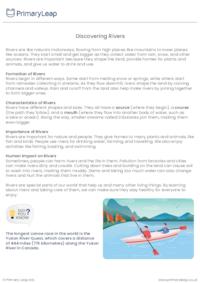
This handy geography worksheet is designed to help KS2 students learn about the fascinating world of rivers. Through a series of thought-provoking questions and activities, students will explore the formation, characteristics, importance, and human impact on rivers. It provides educators with a valuable resource for teaching key concepts in KS2 geography while promoting curiosity and environmental awareness among students.
 New
New
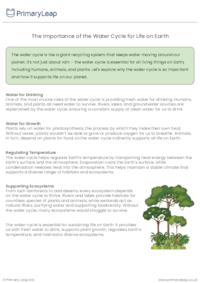
Design a poster activityThe water cycle is like a giant recycling system that keeps water moving around our planet. It's not just about rain – the water cycle is essential for all living things on Earth, including humans, animals, and plants. This handy worksheet provides KS2 students with information about the importance of the water cycle for life on Earth, including examples of how humans, animals, and plants depend on it. Students can use this information to create a poster illustrating these key points.
 Free
Free
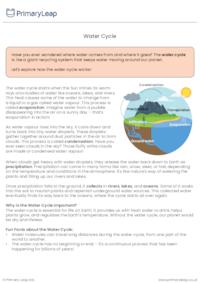
Exploring the Water Cycle - KS2 Worksheet ActivityThis engaging worksheet activity focuses on exploring the water cycle with KS2 students. Through a series of thought-provoking questions and activities, students will deepen their understanding of the water cycle's key stages and importance in Earth's ecosystems. This activity is designed to be interactive, encouraging students to reflect, discuss, and apply their knowledge in creative ways.Worksheet Content:The worksheet includes a series of questions related to the text about the water cycle, covering topics such as evaporation, condensation, precipitation, and the importance of the water cycle.Students are prompted to reflect on their own observations and experiences related to the water cycle, as well as to consider hypothetical scenarios and apply their knowledge creatively.The worksheet also includes multiple-choice questions to assess students' comprehension of key concepts and processes involved in the water cycle.
 New
New
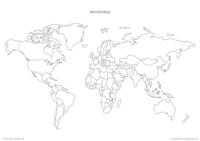
Blank World Map This blank world map is a versatile and valuable resource for educators teaching KS2 geography. Whether used as a standalone activity or integrated into lesson plans, this map encourages kids to explore and engage with key geographical concepts. Educators can use the map as a tool for teaching kids about the location of different countries around the world. Students can label countries, capital cities, and key landmarks.Whether used for basic geographical identification or more complex analysis of global issues, this map provides students with a foundation for understanding the world around them and encourages active exploration and learning.
 New
New
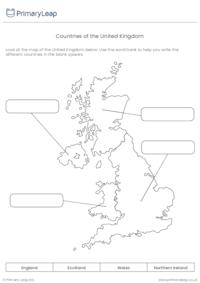
Countries of the United Kingdom ActivityThis engaging worksheet is designed to reinforce students' locational knowledge of the countries comprising the United Kingdom: England, Scotland, Wales, and Northern Ireland. By accurately labelling these countries on a map, students will deepen their understanding of UK geography and develop spatial awareness skills.The primary objective of this worksheet is to familiarise students with the geographical locations of the countries within the United Kingdom. Through this activity, students will enhance their ability to identify and differentiate between these countries on a map. Encourage students to compare and contrast the countries of the United Kingdom in terms of size, population, and geographical features.
 New
New
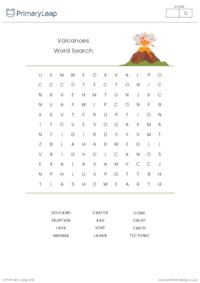
Embark on an exciting journey into the world of volcanoes with this engaging KS2 geography word search! Designed to captivate young minds and reinforce key vocabulary related to volcanic activity, this word search is an ideal educational tool for parents and teachers alike. Usage:Perfect for classroom activities, homework assignments, or educational enrichment at home.Suitable for individual or group work, fostering collaboration and peer learning.
 New
New
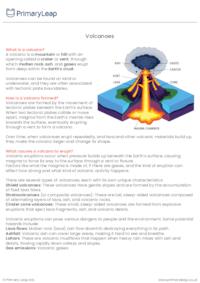
UKS2 Volcanoes ActivityThis engaging worksheet introduces students (UKS2) to the fascinating world of volcanoes. Through clear and concise explanations, students will learn about the formation of volcanoes, why they erupt, different types of volcanoes, associated dangers, and safety precautions during eruptions. Accompanied by a colourful diagram, this worksheet offers a comprehensive overview of volcanoes, making it an excellent resource for educators, parents, and teachers seeking to enhance their students' understanding of Earth's dynamic geological features. This resource can either be used in the classroom or at home.
 New
New
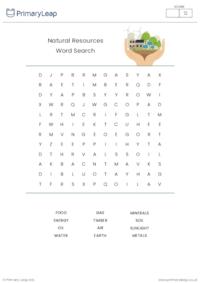
Natural Resources Word SearchWord searches are not just fun puzzles; they're valuable educational tools that can enhance learning experiences for KS2 students in geography and beyond. Whether used in classrooms or at home, word searches offer numerous benefits for young learners. They provide an engaging way for students to familiarise themselves with vocabulary related to natural resources. By searching for and identifying words like "water," "minerals," and "energy," students reinforce their understanding of key terms essential for geography lessons.Word searches offer a fun and engaging way to learn, making them suitable for both classroom use and independent study at home. Students are motivated to complete the puzzle as they enjoy the challenge of finding and circling the hidden words. By incorporating word searches focused on natural resources into your KS2 geography curriculum, you can create an enriching learning experience that sparks curiosity and deepens students' understanding of the world around them. Whether used as standalone activities or integrated into broader lesson plans, word searches offer a dynamic and effective way to engage students in exploring the fascinating topic of natural resources.
 New
New
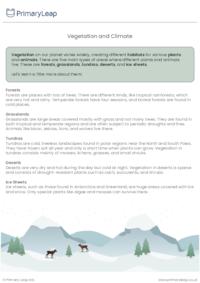
This engaging worksheet is designed to introduce KS2 students to the fascinating world of Earth's biomes – the diverse habitats that shape our planet's landscapes and support a wide variety of plant and animal life.Students will explore five main types of biomes: forests, grasslands, tundras, deserts, and ice sheets. They'll learn about the unique characteristics of each biome, from the towering trees of forests to the frozen expanses of ice sheets.Aligned with the UK national curriculum, this worksheet encourages students to match biome characteristics, identify vegetation types, and understand the environmental factors that influence each biome. It's a fantastic resource for sparking curiosity and deepening geographical knowledge.
 New
New
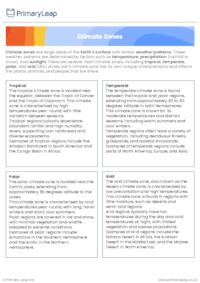
KS2 Climate Zones WorksheetThis KS2 geography worksheet, "Climate Zones," is designed to help educators teach students about the different climate zones found on Earth. Through engaging descriptions and thought-provoking questions, students will explore the characteristics of tropical, temperate, polar, and arid climate zones.The worksheet begins with brief descriptions of each climate zone, providing key information about their locations, temperature patterns, vegetation, and examples of regions within each zone. Students will learn about the unique features of tropical regions near the equator, temperate regions with distinct seasons, polar regions with extreme cold temperatures, and arid regions with low precipitation levels.Educators can use this worksheet as part of their geography curriculum to introduce or reinforce the concept of climate zones. It can be used in classroom settings, as homework assignments, or as supplementary material for independent study. By completing this worksheet, students will gain a deeper understanding of the diverse climates that exist across the globe and the factors that influence them.
 New
New
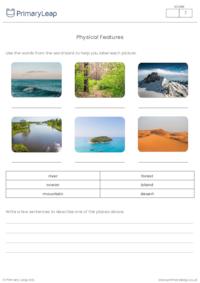
Our Labelling Physical Features activity is designed to engage KS1 students in learning about key geographical features such as mountains, oceans, deserts, rivers, forests, and islands. This worksheet aims to develop students' understanding of these features and their significance in shaping our planet's landscapes.How will this worksheet help my students?The objective of this worksheet is to help students identify and label different physical features correctly, enhancing their knowledge of basic geography concepts.
 New
New
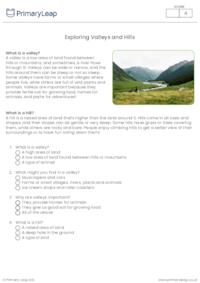
KS1 Valleys and Hills WorksheetIn this worksheet, students will explore the characteristics and significance of valleys and hills through simple and relatable descriptions. They will learn about the defining attributes of valleys, including their low-lying nature, association with hills or mountains, and the presence of rivers. Additionally, students will discover the various features of hills, such as their raised elevation, diverse shapes, and the enjoyment people derive from them.Educational Objectives:Identify the key characteristics of valleys and hills.Understand the importance of valleys and hills in the environment.Develop comprehension skills through reading and answering questions.Foster an appreciation for the natural world and its diverse landscapes.How to Use:Download and distribute the worksheet to students.Encourage students to read the passages about valleys and hills carefully.Have students answer the comprehension questions provided, either independently or in small groups.Review the answers together as a class, discussing any misconceptions and reinforcing key concepts.Download the worksheet today and embark on an exciting journey of discovery with your KS1 students!
 New
New
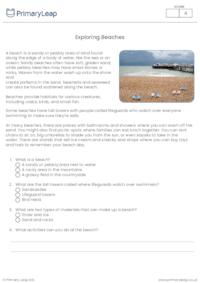
KS1 Exploring Beaches Worksheet"Exploring Beaches" offers a comprehensive and engaging resource for KS1 geography lessons, providing students with a deeper understanding of coastal environments. Following the exploration of beaches, students will engage in comprehension questions that reinforce their understanding of the material covered. These questions are designed to assess students' knowledge of beach features and their ability to recall information from the passage.Educational Goals:Understand what beaches are and where they're found.Recognise and describe natural and human-made features of beaches.Practise reading and comprehension skills in a fun and relaxed setting.Develop a love for exploring nature and the great outdoors.
 New
New
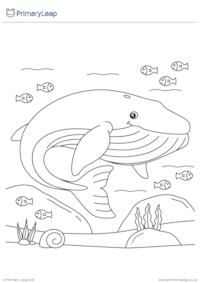
Created for KS1 geography lessons, this worksheet encourages young adventurers to explore the depths of the ocean while expressing their creativity through colouring. Students will embark on an exciting journey to discover the largest creature in the ocean, the magnificent blue whale.Fun Facts about Blue Whales:Blue whales are the largest animals on Earth, growing up to 100 feet long and weighing as much as 200 tons.They have a deep blue-grey colouration and a distinctive mottled appearance.Blue whales consume up to 4 tons of krill, their primary food source, in a single day.Their powerful vocalizations, known as whale songs, can be heard across vast distances in the ocean.Blue whales undertake long migrations between feeding and breeding grounds.
 New
New
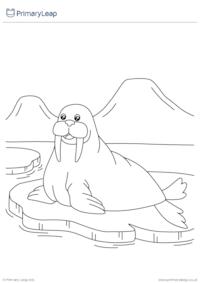
Embark on a thrilling Arctic adventure with our Walrus Colouring Activity! Tailored for KS1 geography lessons, this worksheet invites young explorers to journey to the icy waters of the Arctic while expressing their creativity through colouring. Introduce students to intriguing tidbits about walruses, such as their impressive tusks, blubbery bodies, and unique adaptations for Arctic survival. Learning about these remarkable creatures adds excitement and curiosity to the colouring experience.Fun Facts about Walruses:Walruses are large marine mammals that inhabit the Arctic Ocean and surrounding seas.They are known for their distinctive tusks, which are elongated canine teeth used for various purposes, including foraging and defence.Walruses have a thick layer of blubber that helps them stay warm in cold Arctic waters.They use their sensitive whiskers to detect food on the ocean floor, such as clams and other shellfish.Walruses are highly social animals and often gather in large groups, known as herds, on land and ice floes.
 New
New
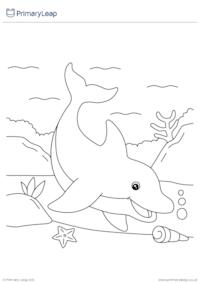
Colouring has been shown to have calming effects on students, promoting relaxation and reducing stress levels. This activity provides a tranquil and enjoyable learning experience, allowing students to unwind as they connect with the ocean and its inhabitants. Tailored for KS1 geography lessons on the five oceans, this worksheet invites young learners to embark on an exciting journey through the depths of the sea while expressing their creativity through colouring.Fun Facts about Dolphins:Dolphins are highly intelligent mammals, known for their complex social behaviours and communication skills.They use echolocation, a type of sonar, to navigate and locate prey underwater.Dolphins are incredibly playful animals and often engage in acrobatic displays, riding waves and leaping out of the water.Some dolphin species, such as the bottlenose dolphin, can swim at speeds of up to 20 miles per hour.Dolphins are known for their strong bonds with each other and often form close-knit groups called pods.
 New
New
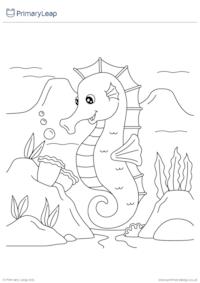
Colouring has calming effects on students, promoting relaxation and reducing stress levels. This activity provides a peaceful and enjoyable learning experience, allowing students to unwind as they dive into the world of seahorses. Perfect for KS1 geography lessons on the five oceans, this worksheet invites young explorers to dive into the whimsical realm of seahorses while unleashing their creativity through colouring.
 New
New
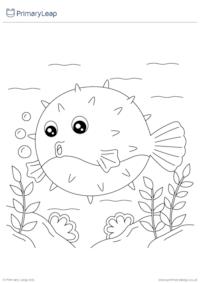
Embark on an undersea journey filled with wonder and excitement with our delightful Pufferfish Colouring Activity! This engaging worksheet is designed to accompany KS1 geography lessons on the five oceans, offering young learners an opportunity to discover the unique charm of the pufferfish while unleashing their creativity through the art of colouring. Introduce students to some fascinating facts about pufferfish, such as their ability to inflate themselves when threatened and their unique defence mechanisms. Learning about these quirky characteristics adds an element of fun and curiosity to the colouring activity.
 New
New
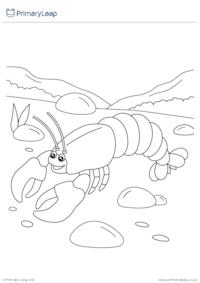
Spark your students' sense of wonder and curiosity with our Lobster Colouring Activity, a delightful addition to your KS1 geography lessons on the five oceans. Through the exploration of marine life, students embark on a journey of discovery and creativity, deepening their connection to the natural world and fostering a lifelong appreciation for the beauty and diversity of ocean ecosystems.
 Free
Free
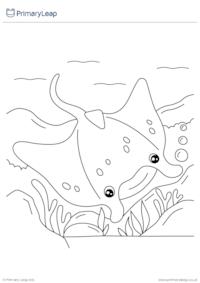
Ignite your students' curiosity and imagination with this Stingray Colouring Activity, a perfect addition to your KS1 geography lessons on the five oceans. Through the exploration of marine creatures, students embark on a journey of discovery and creativity, fostering a deeper connection to the natural world and the wonders that lie beneath the waves.
 New
New
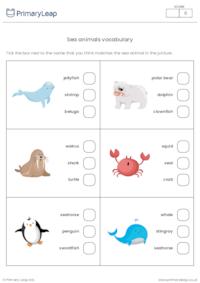
Incorporating this sea animal identification worksheet into KS1 geography lessons not only adds an element of excitement and engagement but also empowers students to actively explore and appreciate the wonders of the natural world. Tailored specifically for KS1 students, this worksheet provides a dynamic platform for young learners to delve into the captivating world of marine life while honing essential academic skills.
 New
New
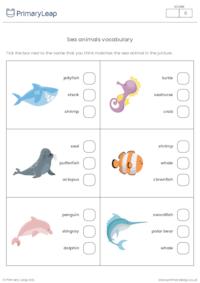
Sea Animals Vocabulary WorksheetThis sea animal identification worksheet is a fantastic addition to KS1 geography lessons, offering a fun way for students to learn about the five oceans and the creatures that inhabit them. By engaging with colourful illustrations and multiple-choice options, children can deepen their understanding of marine ecosystems while honing their academic skills in an enjoyable way.
 New
New
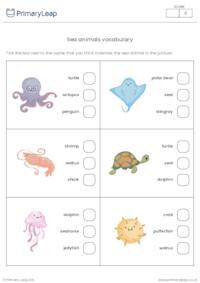
Sea Animals Vocabulary This handy worksheet is designed to engage KS1 pupils in an interactive learning activity focused on identifying sea animals. With colourful illustrations and multiple-choice options, this worksheet provides an opportunity for children to strengthen their knowledge of marine life while practising their decision-making skills.
 New
New
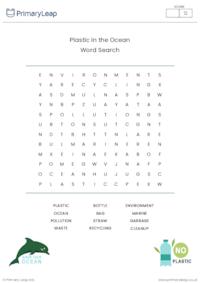
Plastic in the Ocean Word Search ActivityOur "Plastic in the Ocean Word Search" worksheet is an engaging and educational activity designed for KS1 pupils to learn about the issue of plastic pollution in the ocean. This word search provides a fun way for students to familiarise themselves with vocabulary related to this important environmental topic.Benefits:Helps students learn and recognise words related to plastics in the ocean, such as "plastic," "pollution," "recycling," and more.Raises awareness about the impact of plastic pollution on marine life and the environment.Enhances students' vocabulary by introducing new words and concepts related to environmental conservation.Encourages students to think critically about environmental issues and the importance of reducing plastic waste.
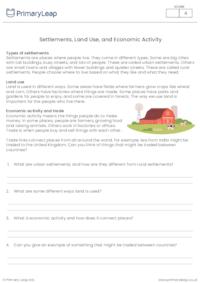
Settlements and Economic ActivityWith this KS2 geography worksheet, students will learn about different types of settlements, how land is used, and the important concepts of economic activity and trade links. Let's dive into the fascinating world of settlements and economic activity. Settlements are places where people live, and economic activities are all the things people do to earn a living.
 Free
Free
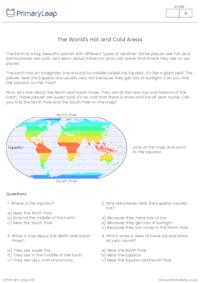
The World's Hot and Cold AreasThis colourful engaging worksheet will help pupils identify the location of hot and cold areas of the world in relation to the Equator and the North and South Poles. Students read through the text and answer the multiple-choice questions.
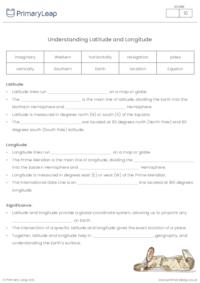
Latitude and Longitude Cloze ActivityThis engaging cloze activity is designed for KS2 students to reinforce their understanding of latitude and longitude. By completing the missing words in sentences, students will enhance their comprehension of these geographical coordinates.
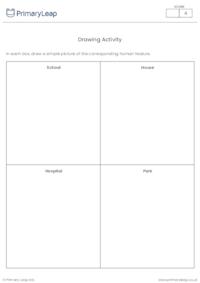
Human Features Drawing Activity This drawing activity aims to help students visually represent and understand various human features within their community.
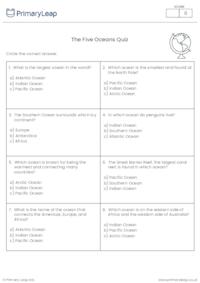
Explore the Oceans Quiz for KS1 PupilsThis quiz isn't just about finding the right answers - it's a journey to explore our amazing oceans! Pupils learn which ocean is the biggest, discover where penguins live, and find out that some oceans are warm while others are icy. Children read through the questions and circle the correct answer from the options (a, b, or c).
 Free
Free
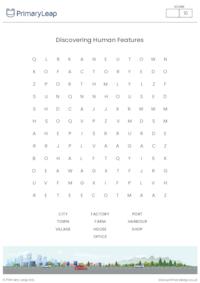
KS1 Human Features word search activityEmbark on a fun and educational journey with this engaging KS1 word search! This activity is designed for young learners to discover and recognise various human features in their surroundings. The following words are hidden within the puzzle: city, town, village, factory, farm, house, office, port, harbour, and shop. Students search horizontally, vertically, and diagonally to find each hidden word.This word search not only enhances vocabulary but also introduces young learners to diverse human features, fostering an early understanding of the various places where people live, work, and engage in daily activities.
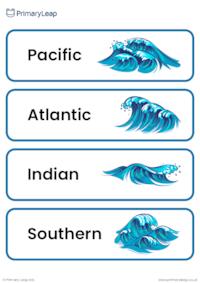
The Five Oceans Vocabulary CardsUse these vocabulary cards to spark curiosity about the world's oceans. Each card provides the name and location of one of the five oceans. Whether used in classrooms or homeschooling settings, they provide an engaging resource for geography lessons, homework, vocabulary building, or matching activities.
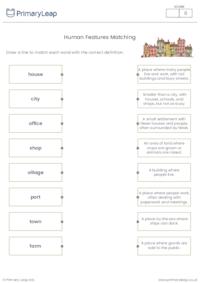
Human features matching activityThis matching activity asks students to match the descriptions of each human feature with the correct name. This will help learners use basic geographical vocabulary to refer to key human features, including: city, town, village, farm, house, office, port, and shop.
 Free
Free
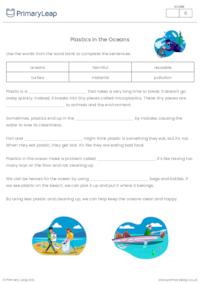
Plastics in the OceansThis handy geography worksheet will enhance students' understanding and knowledge about the critical issue of plastic pollution in the oceans. By filling in the blanks in this cloze activity, students will learn about why it's important to keep the oceans clean and how plastic can harm the animals that live there.
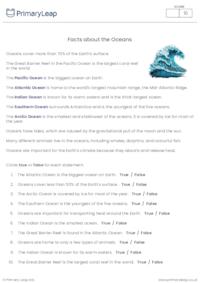
Facts about the Oeans worksheetTeachers and parents can use this worksheet as part of a lesson on geography or as a standalone activity to spark curiosity about the oceans. It's a blend of fun and education, ensuring that young learners enjoy the process of discovering interesting facts about our oceans. Students read through the facts about our oceans and circle true or false after each statement.
 Free
Free
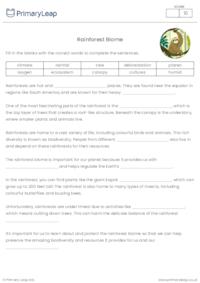
Rainforest Biome Cloze ActivityThis worksheet introduces students to the concept of biomes and their unique characteristics. Through reading and filling in the blanks, students gain a better understanding of the rainforest biome's location, climate, and distinct features. Use this KS2 resource in the classroom or at home.
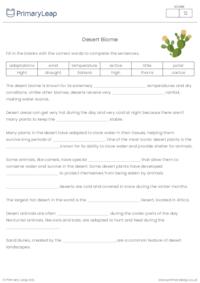
Desert Biome Cloze ActivityThis worksheet focuses on the desert biome, a unique and fascinating ecosystem found around the world. Deserts may seem barren, but they are full of remarkable adaptations and survival strategies. This educational resource is designed to engage KS2 pupils in exploring the characteristics, plants, and animals of the desert biome while enhancing their understanding of this challenging environment.The Desert Biome worksheet introduces students to key concepts related to desert ecosystems. Pupils will engage in a fill-in-the-blanks exercise where they can apply their knowledge of desert features, climate, and adaptations. This activity encourages critical thinking and reinforces essential facts about desert biomes. Use this desert biome worksheet to spark interest, deepen understanding, and inspire further exploration of our planet's diverse ecosystems.
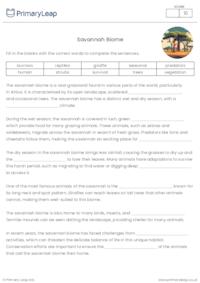
Savannah Biome Cloze ActivityThis engaging and educational resource aims to introduce students to the fascinating world of the savannah biome – a unique and diverse ecosystem found in various parts of the world, particularly in Africa. This worksheet will provide pupils with a deeper understanding of the savannah biome's characteristics, climate, plant and animal adaptations, as well as the challenges it faces. Through a fill-in-the-blanks exercise, students will actively engage with key concepts related to the savannah, enhancing their knowledge of this remarkable habitat.
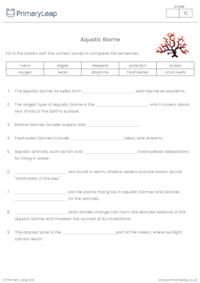
Aquatic Biome Cloze ActivityThis cloze activity worksheet on aquatic biomes is designed to engage KS2 pupils in an exciting journey through the world's water-based ecosystems. Students will have the opportunity to test their knowledge about aquatic biomes by completing sentences with the appropriate words. By doing so, they will reinforce their understanding of important concepts related to oceans, rivers, lakes, and other aquatic environments. This activity encourages critical thinking as students recall information about the unique features and inhabitants of these biomes.
 Free
Free
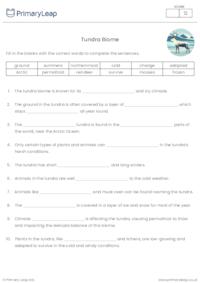
Tundra cloze activityThis worksheet is designed to enhance your pupils' understanding of the unique characteristics, plant life, and animal adaptations that make the tundra such a fascinating and extreme environment. Through this activity, students will reinforce their knowledge of the tundra biome while practising important reading and comprehension skills. As students fill in the blanks with the appropriate words, they will demonstrate their understanding of key concepts related to the tundra biome.
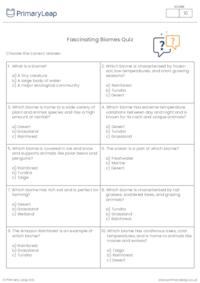
Biomes QuizOur Fascinating Biomes Quiz is a great activity designed to enhance your students' understanding of the different biomes that exist around the world. This quiz is a fun and educational way for students to learn about the unique characteristics and plant and animal life. There are 10 multiple-choice questions for children to answer. Incorporate the "Fascinating Biomes Quiz" into your lesson plan or use this fun resource at home.
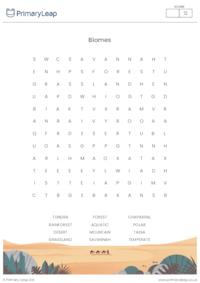
Biomes word searchKS2 pupils will have fun discovering the different biomes that cover our Earth's surface, from the icy tundras to the lush rainforests and arid deserts. Pupils search for 12 hidden words related to these incredible biomes.
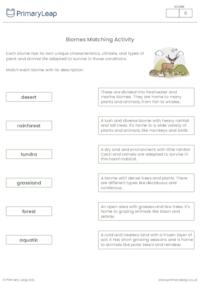
Biomes Matching Activity WorksheetIn this engaging worksheet, pupils will explore the fascinating world of biomes – diverse ecosystems that cover our planet. Their task is to match each biome with its description. Biomes are unique regions with distinct climates, landscapes, and plant and animal life. Happy learning and exploring the amazing biomes of our planet!
 Free
Free
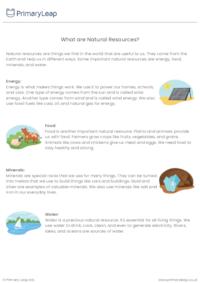
What are Natural Resources?This handy worksheet is designed to introduce KS2 students to the concept of natural resources and their distribution. Through this worksheet, students will gain a better understanding of essential resources like energy, food, minerals, and water, and how they are distributed around the world. The worksheet includes an informative passage that explains the importance of natural resources and their diverse uses. Students will be asked multiple-choice questions, to think about the importance of water conservation, and come up with simple ways they can contribute to saving water in their daily lives.
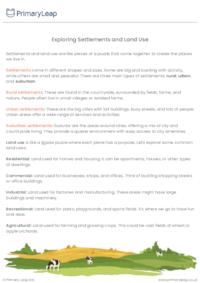
Exploring Settlements and Land UseThis worksheet is designed to introduce pupils to the concepts of settlements and land use. It will help pupils understand the diverse ways land is used for different purposes. Children will explore rural and urban settlements, grasp the significance of proper land use planning, and gain insights into the connections between human activities and the environment. There are multiple-choice questions and answers included in this resource.
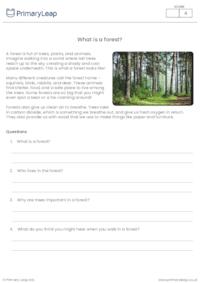
What is a forest? Reading comprehension activityOur "What is a forest?" reading comprehension is a magical journey into the heart of nature, specially crafted for curious minds in KS1. In this comprehension, young learners will discover the wonders of a forest – a special place where tall trees stand like guardians, animals play hide-and-seek, and the air feels fresh and clean. As they read, they will explore the soft ground covered in moss and leaves, and meet adorable creatures like squirrels, rabbits, and birds, each finding a cozy home among the trees.
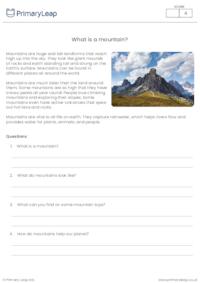
What is a mountain? Reading comprehension activityThis short reading comprehension activity aims to introduce KS1 pupils to the basic concept of mountains in a simple and understandable way. It focuses on key features and characteristics of mountains, making it suitable for young learners.
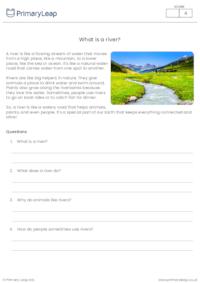
What is a river? Reading Comprehension ActivityThis comprehension activity can be used to introduce young learners to the enchanting world of rivers. This resource aims to provide an engaging and informative experience for your KS1 pupils as they begin to understand the significance of rivers in our natural environment. Through this comprehension, children will gain insights into the role of rivers, their importance for various forms of life, and how they contribute to the delicate balance of ecosystems. The comprehension is tailored to meet the developmental needs of KS1 pupils, offering clear and concise explanations along with comprehension questions that encourage critical thinking and reflection. Use this worksheet in the classroom or at home.
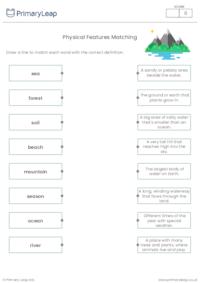
Physical Features Matching ActivityIn this worksheet, pupils will learn about a variety of physical features that shape our planet's diverse landscapes. As pupils connect each word on the left with its definition on the right, they'll deepen their knowledge of these fundamental elements. Key physical features include sea, forest, soil, beach, mountain, season, ocean, and river.




Check out our ready-to-use Geography worksheets that can be used in the classroom or at home. Simply download or print and watch your child’s confidence grow with our easy to follow Geography printables.


One of the best things about printable worksheets is that they make learning fun and easy. Explore our educational resources based on Geography and keep your children learning through these fun and engaging exercises.


Our Geography printable worksheets are designed for progressive learning. Our engaging content enables a child to learn at their own speed and gain confidence quickly. When we help a child believe in themselves, we empower them for life.


Printable worksheets are a great way to enhance creativity and improve a child’s knowledge. Help your child learn more about Geography with this great selection of worksheets designed to help children succeed.
An email has been sent to your account please activate your account to continue.

PrimaryLeap has introduced a new interactive learning platform and would like to offer you a completely Free Upgrade.
We understand that you may only want to use our services for worksheets and may not want to upgrade your account.
But if you are interested in trying out our new services then you're just a click away.
An email has been sent to your account please activate your account to continue.
You've answered
and have 2 Questions remaining
Import multiple students information through a CSV File. Browse or drag .CSV file below.